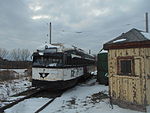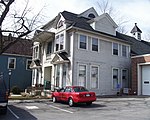Honeoye Creek
Finger Lakes, New York geography stubsGenesee RiverNew York (state) river stubsRivers of Livingston County, New YorkRivers of Monroe County, New York ... and 2 more
Rivers of New York (state)Rivers of Ontario County, New York

Honeoye Creek ( HUN-ee-oy) is a tributary of the Genesee River in western New York in the United States. The name Honeoye is from the Seneca word ha-ne-a-yah, which translates to "lying finger", or "where the finger lies". The name refers to the local story of a Native American who had his finger bitten by a rattlesnake and therefore cut off his finger with a tomahawk.
Excerpt from the Wikipedia article Honeoye Creek (License: CC BY-SA 3.0, Authors, Images).Honeoye Creek
Golah Road,
Geographical coordinates (GPS) Address Nearby Places Show on map
Geographical coordinates (GPS)
| Latitude | Longitude |
|---|---|
| N 42.971111111111 ° | E -77.718611111111 ° |
Address
Golah Road 260
14543
New York, United States
Open on Google Maps











